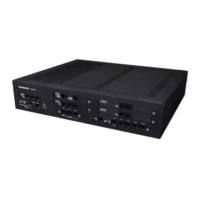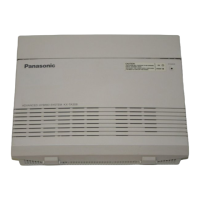c. Extensions in Tenant 3 are either COS 5 or 6. They can make calls to other extensions in Tenant 3
only.
COS 6COS 1 COS 2
Extension User
Group 1
Tenant 1
Extn. 100 Extn. 101
Extension User
Group 2
Extn. 103Extn. 102
COS 5
Extension User
Group 5
Tenant 3
Extn. 108 Extn. 109
Extension User
Group 6
Extn. 111Extn. 110
COS 3 COS 4
Extension User
Group 3
Tenant 2
Extn. 104 Extn. 105
Extension User
Group 4
Extn. 107Extn. 106
External Call Block
If multiple tenants are using the PBX, the External Call Block feature should be programmed to control
which
COS numbers are allowed to access which trunk groups. By preventing certain COS numbers from
accessing certain trunk groups, each tenant can be given its own trunk groups which no other tenant can
access.
[Programming Example: External Call Block]
COS
Trunk
Group 1
Trunk
Group 2
Trunk
Group 3
Trunk
Group 4
Trunk
Group 5
Trunk
Group 6
COS 1
COS 2
COS 3
COS 4
COS 5
COS 6
Block
Block
Block
Block
Block
Block
Block
Block
Block
Block
Block
Block
Block
Block
Block
Block
Block
Block
Block
Block
Block
Block
Block
Block
In this example:
External Call Block is employed to prevent tenants from accessing all trunk groups except the ones
designated
to them. Each extension in a tenant is assigned a COS that is not assigned to extensions which
belong to another tenant.
a. Extensions in Tenant 1 are either COS 1 or 2. They can access trunk groups 1 and 2.
b. Extensions in Tenant 2 are either COS 3 or 4. They can access trunk groups 3 and 4.
Document Version 2016-03 Feature Manual 369
19.1.2 Tenant Service

